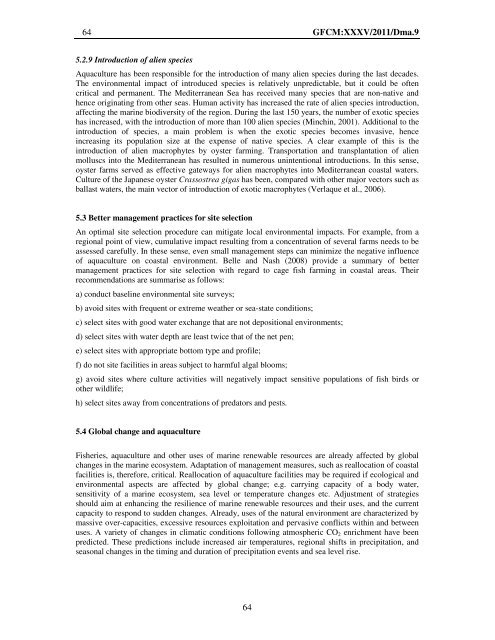Site selection and carrying capacity in Mediterranean ... - FAO Sipam
Site selection and carrying capacity in Mediterranean ... - FAO Sipam
Site selection and carrying capacity in Mediterranean ... - FAO Sipam
You also want an ePaper? Increase the reach of your titles
YUMPU automatically turns print PDFs into web optimized ePapers that Google loves.
64 GFCM:XXXV/2011/Dma.9<br />
5.2.9 Introduction of alien species<br />
Aquaculture has been responsible for the <strong>in</strong>troduction of many alien species dur<strong>in</strong>g the last decades.<br />
The environmental impact of <strong>in</strong>troduced species is relatively unpredictable, but it could be often<br />
critical <strong>and</strong> permanent. The <strong>Mediterranean</strong> Sea has received many species that are non-native <strong>and</strong><br />
hence orig<strong>in</strong>at<strong>in</strong>g from other seas. Human activity has <strong>in</strong>creased the rate of alien species <strong>in</strong>troduction,<br />
affect<strong>in</strong>g the mar<strong>in</strong>e biodiversity of the region. Dur<strong>in</strong>g the last 150 years, the number of exotic species<br />
has <strong>in</strong>creased, with the <strong>in</strong>troduction of more than 100 alien species (M<strong>in</strong>ch<strong>in</strong>, 2001). Additional to the<br />
<strong>in</strong>troduction of species, a ma<strong>in</strong> problem is when the exotic species becomes <strong>in</strong>vasive, hence<br />
<strong>in</strong>creas<strong>in</strong>g its population size at the expense of native species. A clear example of this is the<br />
<strong>in</strong>troduction of alien macrophytes by oyster farm<strong>in</strong>g. Transportation <strong>and</strong> transplantation of alien<br />
molluscs <strong>in</strong>to the <strong>Mediterranean</strong> has resulted <strong>in</strong> numerous un<strong>in</strong>tentional <strong>in</strong>troductions. In this sense,<br />
oyster farms served as effective gateways for alien macrophytes <strong>in</strong>to <strong>Mediterranean</strong> coastal waters.<br />
Culture of the Japanese oyster Crassostrea gigas has been, compared with other major vectors such as<br />
ballast waters, the ma<strong>in</strong> vector of <strong>in</strong>troduction of exotic macrophytes (Verlaque et al., 2006).<br />
5.3 Better management practices for site <strong>selection</strong><br />
An optimal site <strong>selection</strong> procedure can mitigate local environmental impacts. For example, from a<br />
regional po<strong>in</strong>t of view, cumulative impact result<strong>in</strong>g from a concentration of several farms needs to be<br />
assessed carefully. In these sense, even small management steps can m<strong>in</strong>imize the negative <strong>in</strong>fluence<br />
of aquaculture on coastal environment. Belle <strong>and</strong> Nash (2008) provide a summary of better<br />
management practices for site <strong>selection</strong> with regard to cage fish farm<strong>in</strong>g <strong>in</strong> coastal areas. Their<br />
recommendations are summarise as follows:<br />
a) conduct basel<strong>in</strong>e environmental site surveys;<br />
b) avoid sites with frequent or extreme weather or sea-state conditions;<br />
c) select sites with good water exchange that are not depositional environments;<br />
d) select sites with water depth are least twice that of the net pen;<br />
e) select sites with appropriate bottom type <strong>and</strong> profile;<br />
f) do not site facilities <strong>in</strong> areas subject to harmful algal blooms;<br />
g) avoid sites where culture activities will negatively impact sensitive populations of fish birds or<br />
other wildlife;<br />
h) select sites away from concentrations of predators <strong>and</strong> pests.<br />
5.4 Global change <strong>and</strong> aquaculture<br />
Fisheries, aquaculture <strong>and</strong> other uses of mar<strong>in</strong>e renewable resources are already affected by global<br />
changes <strong>in</strong> the mar<strong>in</strong>e ecosystem. Adaptation of management measures, such as reallocation of coastal<br />
facilities is, therefore, critical. Reallocation of aquaculture facilities may be required if ecological <strong>and</strong><br />
environmental aspects are affected by global change; e.g. <strong>carry<strong>in</strong>g</strong> <strong>capacity</strong> of a body water,<br />
sensitivity of a mar<strong>in</strong>e ecosystem, sea level or temperature changes etc. Adjustment of strategies<br />
should aim at enhanc<strong>in</strong>g the resilience of mar<strong>in</strong>e renewable resources <strong>and</strong> their uses, <strong>and</strong> the current<br />
<strong>capacity</strong> to respond to sudden changes. Already, uses of the natural environment are characterized by<br />
massive over-capacities, excessive resources exploitation <strong>and</strong> pervasive conflicts with<strong>in</strong> <strong>and</strong> between<br />
uses. A variety of changes <strong>in</strong> climatic conditions follow<strong>in</strong>g atmospheric CO2 enrichment have been<br />
predicted. These predictions <strong>in</strong>clude <strong>in</strong>creased air temperatures, regional shifts <strong>in</strong> precipitation, <strong>and</strong><br />
seasonal changes <strong>in</strong> the tim<strong>in</strong>g <strong>and</strong> duration of precipitation events <strong>and</strong> sea level rise.<br />
64
















